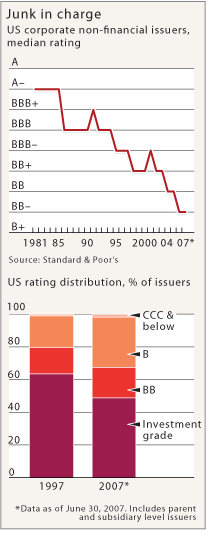Default rates
Roula Khalaf, Editor of the FT, selects her favourite stories in this weekly newsletter.
Dystopian visions of the future often portray humanity drowning in its own junk. The future is now. More than half the US issuers rated by Standard & Poor’s are currently graded as “speculative”. The proportion rated “B” or lower – well into junk territory – has jumped from one-fifth in 1997 to about one-third currently. The paradox is that the default rate for speculative grade bonds, globally, stands at a 25-year low.

Extraordinary risk appetite and benign economic conditions have led lenders to take on more low-quality paper. Borrowers have been able to tap new funding at will. But the recent seizing-up of credit markets shows that many lenders are rediscovering the concept of risk. As refinancing becomes harder, the result is likely to be a sharp increase in defaults, particularly if the economy weakens significantly.
Easier lending terms – taken to the extreme with so-called covenant-lite agreements – strip out many of the usual default triggers. But that “see-no-evil” approach means credit can deteriorate out of the spotlight. Defaults can then occur with little warning and subsequent recovery rates are likely to be weak.
Optimists may point out that just 11 per cent of the $2,910bn of US corporate debt rated by S&P falls due by the end of 2008. But focusing on maturities misses the point. Analysis of defaults from 1971-2006 by Professor Ed Altman of New York University’s Stern School of Business shows that defaults for junk bonds tend to spike two to four years after issuance. Some 73 per cent of US paper rated “B-” or lower by S&P is less than five years old. History shows that, well before maturity, weak credits can struggle to pay interest and meet covenants.
Of the 28 speculative grade issuers that Moody’s assesses for “intrinsic liquidity” – a measure of reliance on market access for funding – 12 are described as “merely adequate” or weak. There were just four new junk issues in July compared with an average of 38 per month in the first half of 2007. That slowdown is not before time but the full fallout from earlier excess is yet to come.
Comments